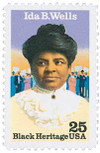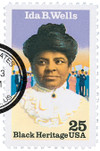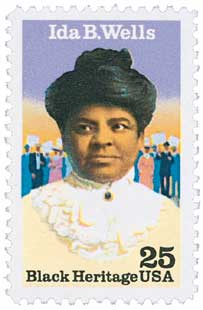
# 2442 - 1990 25c Black Heritage: Ida B. Wells
US #2442
1990 Ida B. Wells
- 13th stamp in the Black Heritage series
- Honors former slave and anti-lynching activist
Stamp Category: Commemorative
Set: Black Heritage Series
Value: 25¢, First-Class mail rate
First Day of Issue: February 1, 1990
First Day City: Chicago, Illinois
Quantity Issued: 153,125,000
Printed by: American Bank Note Company
Printing Method: Photogravure
Format: Panes of 50 from printing cylinders of 200
Perforations: 11
Why the stamp was issued: This stamp was issued during Black History month to honor Ida B. Wells, who fought against lynching and other forms of prejudice.
About the stamp design: Thomas Blackshear created the artwork for the Ida B. Wells stamp. This was his fourth Black Heritage stamp. He was given copies of portraits of Wells that were housed at the University of Chicago, along with her papers. Blackshear made an acrylic painting of Wells using these images as inspiration. He chose protesters in the background to show the work Wells did to try to better the lives of African Americans.
First Day City: The First Day of Issue ceremony was held at the Museum of Science and Industry in Chicago. Some of Wells’s grandsons attended the ceremony.
About the Black Heritage Series: The Black Heritage Series began on February 1, 1978, with the issue of the 13¢ Harriet Tubman stamp (US #1744). Since then, the USPS has issued a new stamp in the series every year. A number of them have even been released in February in recognition of Black History month. As of 2023, it was the USPS’s longest-running stamp series of all time.
History the stamp represents:
Ida Bell Wells was born July 16, 1862, in Holly Springs, Mississippi, just before President Abraham Lincoln issued his Emancipation Proclamation. After the Civil War, Wells’ parents were freed and she attended the freedman’s school Shaw University. Then, at the age of 14, both her parents and her 10-month-old brother died of yellow fever. Rather than allow herself and her five siblings to be split up, Wells dropped out of high school and got a job as a teacher in an African-American school. Discovering that she was only making $30 a month while white teachers were paid $80, Wells grew increasingly interested in racial politics and improving African-American education.
In May 1884, while riding a train, Wells was ordered to give up her train seat to a white man and sit in the already packed “Jim Crow” car. When she refused, she was dragged from the car. Upon returning to Memphis, she hired an attorney and wrote a newspaper article about her experience. After the railroad company paid off her lawyer, she hired a white attorney who won the case and a $500 settlement. Then, in 1887, the Tennessee Supreme Court reversed the ruling and ordered Wells to pay the court costs.
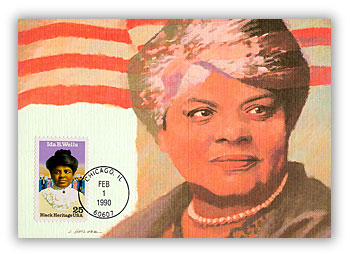
Due to the attention she received from the case, Wells was invited to write weekly editorials for the Evening Star and The Living Way newspapers. Writing under the pen name “Iola,” she quickly gained significant attention for writing about race issues. In 1889, Wells became co-owner and editor of Free Speech and Headlight, an anti-segregationist newspaper.
In 1889, Wells’ friend Thomas Moss and two other black men were arrested and lynched while she was out of town. Shocked at their senseless deaths, she wrote an article urging the black Memphis community to leave the town, “which will neither protect our lives and property, nor give us a fair trial in the courts, but takes us out and murders us in cold blood when accused by white persons.” More than 6,000 people followed her suggestion and left town while others boycotted white-owned businesses. Wells began receiving threats on her life and started carrying a gun. This event also led Wells to research lynchings and what caused them. She found that the underlying reason was actually a resentment of the African-Americans’ economic success.
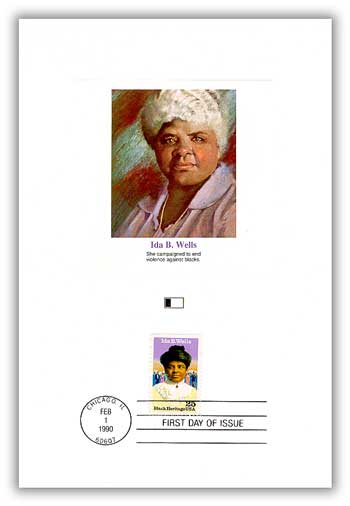
In 1893 and 1894, Wells traveled to Europe to bring international attention to the lynching issue in America. On her second trip, she was asked to write articles for the Daily Inter-Ocean, making her the first African-American woman to be a paid correspondent for a mainstream white paper. Wells’ trips led to the creation of anti-lynching groups in Europe that pressed the U.S. government to guarantee better treatment of its African-American citizens.
Wells continued writing and speaking out for African-American and women’s rights. She was one of only two women to sign “The Call” to form the NAACP and established one of the first black women’s suffrage groups. Wells dedicated the last 30 years of her life to urban reform in Chicago and raising her family. When she retired, Wells began work on her autobiography. But she died on March 25, 1931, before it was completed.
US #2442
1990 Ida B. Wells
- 13th stamp in the Black Heritage series
- Honors former slave and anti-lynching activist
Stamp Category: Commemorative
Set: Black Heritage Series
Value: 25¢, First-Class mail rate
First Day of Issue: February 1, 1990
First Day City: Chicago, Illinois
Quantity Issued: 153,125,000
Printed by: American Bank Note Company
Printing Method: Photogravure
Format: Panes of 50 from printing cylinders of 200
Perforations: 11
Why the stamp was issued: This stamp was issued during Black History month to honor Ida B. Wells, who fought against lynching and other forms of prejudice.
About the stamp design: Thomas Blackshear created the artwork for the Ida B. Wells stamp. This was his fourth Black Heritage stamp. He was given copies of portraits of Wells that were housed at the University of Chicago, along with her papers. Blackshear made an acrylic painting of Wells using these images as inspiration. He chose protesters in the background to show the work Wells did to try to better the lives of African Americans.
First Day City: The First Day of Issue ceremony was held at the Museum of Science and Industry in Chicago. Some of Wells’s grandsons attended the ceremony.
About the Black Heritage Series: The Black Heritage Series began on February 1, 1978, with the issue of the 13¢ Harriet Tubman stamp (US #1744). Since then, the USPS has issued a new stamp in the series every year. A number of them have even been released in February in recognition of Black History month. As of 2023, it was the USPS’s longest-running stamp series of all time.
History the stamp represents:
Ida Bell Wells was born July 16, 1862, in Holly Springs, Mississippi, just before President Abraham Lincoln issued his Emancipation Proclamation. After the Civil War, Wells’ parents were freed and she attended the freedman’s school Shaw University. Then, at the age of 14, both her parents and her 10-month-old brother died of yellow fever. Rather than allow herself and her five siblings to be split up, Wells dropped out of high school and got a job as a teacher in an African-American school. Discovering that she was only making $30 a month while white teachers were paid $80, Wells grew increasingly interested in racial politics and improving African-American education.
In May 1884, while riding a train, Wells was ordered to give up her train seat to a white man and sit in the already packed “Jim Crow” car. When she refused, she was dragged from the car. Upon returning to Memphis, she hired an attorney and wrote a newspaper article about her experience. After the railroad company paid off her lawyer, she hired a white attorney who won the case and a $500 settlement. Then, in 1887, the Tennessee Supreme Court reversed the ruling and ordered Wells to pay the court costs.

Due to the attention she received from the case, Wells was invited to write weekly editorials for the Evening Star and The Living Way newspapers. Writing under the pen name “Iola,” she quickly gained significant attention for writing about race issues. In 1889, Wells became co-owner and editor of Free Speech and Headlight, an anti-segregationist newspaper.
In 1889, Wells’ friend Thomas Moss and two other black men were arrested and lynched while she was out of town. Shocked at their senseless deaths, she wrote an article urging the black Memphis community to leave the town, “which will neither protect our lives and property, nor give us a fair trial in the courts, but takes us out and murders us in cold blood when accused by white persons.” More than 6,000 people followed her suggestion and left town while others boycotted white-owned businesses. Wells began receiving threats on her life and started carrying a gun. This event also led Wells to research lynchings and what caused them. She found that the underlying reason was actually a resentment of the African-Americans’ economic success.

In 1893 and 1894, Wells traveled to Europe to bring international attention to the lynching issue in America. On her second trip, she was asked to write articles for the Daily Inter-Ocean, making her the first African-American woman to be a paid correspondent for a mainstream white paper. Wells’ trips led to the creation of anti-lynching groups in Europe that pressed the U.S. government to guarantee better treatment of its African-American citizens.
Wells continued writing and speaking out for African-American and women’s rights. She was one of only two women to sign “The Call” to form the NAACP and established one of the first black women’s suffrage groups. Wells dedicated the last 30 years of her life to urban reform in Chicago and raising her family. When she retired, Wells began work on her autobiography. But she died on March 25, 1931, before it was completed.








